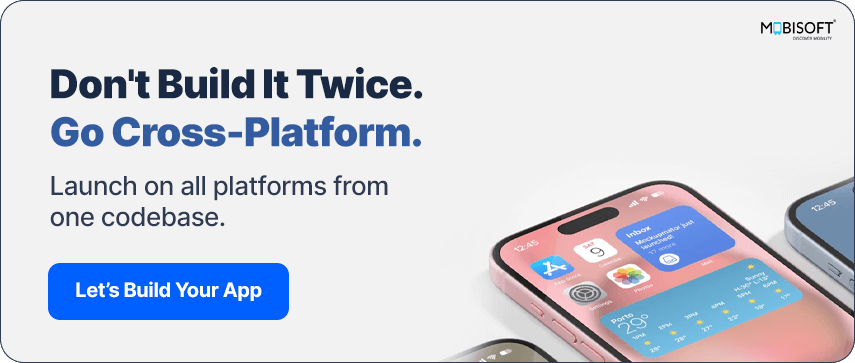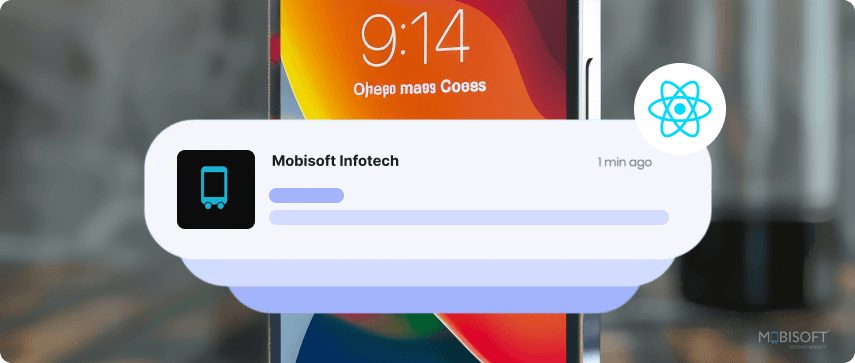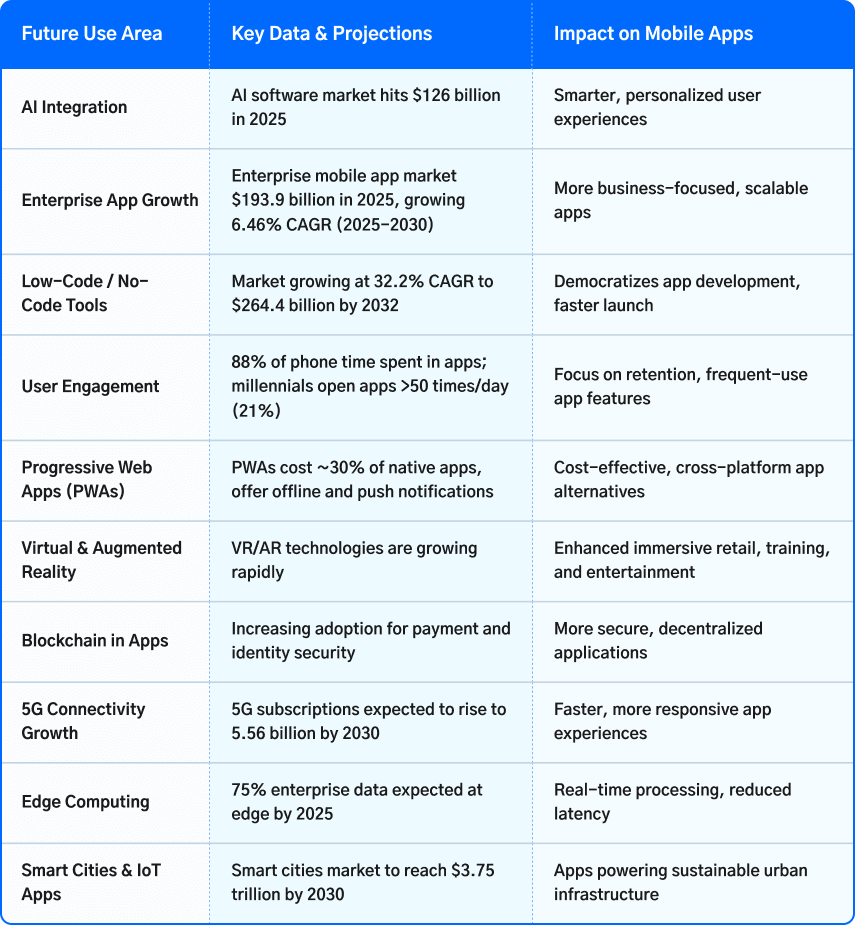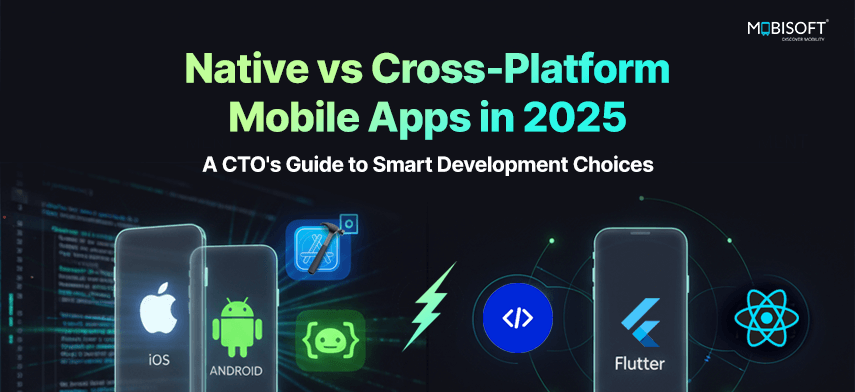The Changing Perspective of Mobile Apps
Since the invention of mobile applications in 1993, the industry has undergone immense changes. With the introduction of AI, the industry is under yet another important transformation. In 2023, people downloaded over 257 billion mobile apps globally. Experts expect mobile app development revenue to reach $613 billion by 2025. The mobile app development market was worth $475.90 billion in 2022. It is set to grow steadily and reach nearly $756 billion by 2027, with an annual growth rate of about 8.58% This fast growth shows how important mobile app development trends have become.
If you are a Chief Technology Officer, making smart choices about cross-platform vs native apps is crucial. This guide will explain both approaches in mobile app development 2025. It will cover their benefits, drawbacks, and which projects each suits best. Technological advancements keep users in anticipation. As a result, it is predicted that by the end of 2025, about 4.69 billion people will own smartphones worldwide. The best mobile app development strategies are therefore crucial to staying at the top.
How Native Apps Are Built with Modern Frameworks
Native apps are built specifically for one platform, either iOS or Android. Developers use languages unique to each platform. Swift is used in iOS, while Android is based on Kotlin. A key difference between these app types is the mobile app development tools needed to build native apps. iOS uses Xcode, Android has its own Android Studio, and those tools are highly specific to their use case, such as writing platform-specific code, handling resources, or making various types of interfaces.

Advantages of Native App Development
- Superior Performance and Speed: Native apps are created specifically for a platform, which means they are inherently faster and more responsive. They are built in consideration of the hardware, which makes them fully compatible.
- Access to Device Features: Native apps must ask permission to use device features such as the camera, GPS, or push notifications, which are built in without asking permission. This creates richer, more interactive apps.
- Enhanced User Experience: Native apps follow platform design principles, so they are authentic in feel and look to the user. This authenticity makes it more enjoyable and convenient to use them.
Explore the Best mobile app development services to build high-performance native apps.
The Trade-Offs of Native Apps
- Higher Development Costs: Different apps on iOS and Android require two codebases and, in many instances, two teams. Mobile app development costs can be as low as $40,000 for a basic app, up to over $400,000 in complex, enterprise-wide efforts. iOS app development in 2025 costs between $55,000 and $500,000. Android development falls in a band from $50,000 to $500,000.
- Longer Time to Market: Multiple app maintenance takes time, costs more money, and can even cause launch delays. Competitive markets don’t allow for such risks..
- Resource Demands: In-house native app development involves larger groups of testers, designers, and developers. That generates overhead and complexity. Annual maintenance generally runs 15 to 20 percent of the initial development outlay.
When is Native the right choice?
Native development is particularly well-suited for applications that require high performance and complex functionalities, such as:
- Gaming Apps: Applications like Fortnite and Call of Duty Mobile employ native development in a bid to generate incredible graphics and smooth gameplay experiences.
- Complex Functionalities: Applications requiring heavy calculation or instantaneous data manipulation, as in Spotify (streaming music) or Instagram (editing and uploading photos), benefit greatly from native functionality.
Current Market Statistics
In 2023, Apple’s App Store earned $85.1 billion. Google Play brought in $47.6 billion. In 2022, Apple held half of global consumer app spending, while Google Play made up 27 percent. This revenue gap shows why choosing the best mobile app development platform is key in native development.
How Cross-Platform App Development Works?
Cross-platform app developers only need to code once, but it is capable of running the apps on multiple devices. This makes the whole process very efficient. Some well-known cross-platform frameworks are Flutter mobile app development, React Native app development, and Xamarin. The result is less development time and lower cost. Check out our Cross-platform app development services to save time and cost.
Cross-Platform Framework Statistics
The cross-platform development industry is increasing at a steady pace. Its value is likely to expand from USD 15.67 billion in 2025 to USD 42.60 billion in 2034. That is an 11.75 percent compound annual growth rate (CAGR). React Native app development is at the second spot, since 32 percent of the developers used it in 2024. Statista data shows Flutter mobile app development holds a 42 percent market share as compared to 38 percent by React Native.
Learn about React Native app development services to enhance cross-platform apps efficiently.
Advantages of Cross-Platform Development
Cost-Effectiveness
A single codebase for all platforms means fewer production and maintenance costs. This attracts small firms and business start-ups. The mobile app development cost falls in the range of $40,000 and $300,000. The cost of cross-platform app development in React Native is 25 to 50 percent lower compared to native development. At times, cross-platform software drops costs by 50 percent and releases the apps into the marketplace 1.5 times earlier.
Faster Development Time
They can reuse 90 percent of the code on both iOS and Android. This reduces costs by as much as 30 percent and accelerates the app development lifecycle. The teams can expedite new features without duplicated efforts.
Easier Maintenance
Apps with cross-platform app development have a shared codebase. This means that updates are reflected on all platforms at once, making them faster and affordable.
Market Performance Statistics
Revenue figures show the financial impact of cross-platform frameworks. In 30 days during Q4 2024, apps built with React Native app development and Flutter mobile app development generated $570 million in net revenue after platform fees. This proves that cross-platform vs native apps can both deliver strong commercial results in mobile app development in 2025.
Limits of Cross-Platform Development
- Potential Performance Issues: Cross-platform development is efficient, but it is less computationally capable than native app development. Especially in computationally intensive operations. Despite the impressive work done by React Native app development, cross-platform apps are yet no match to the benchmarks laid down by native apps.
- Limited Access to Device-Specific Features: Cross-platform development environments often have limited natively supported access to all device features, thus restricting functionality and producing a less integrated user experience.
- UI Inconsistencies: Different operating systems have different requirements, making it very difficult to create a consistent UI.
Where Cross-Platform Shines
Cross-platform development is often ideal for:
- Minimum Viable Products (MVPs): Start-ups seeking to validate ideas can have faster cycles and lower costs.
- Content-Based Apps: Content-distribution apps (such as Walmart or Airbnb) can utilize cross-platform development to ensure consistent functionality and user interface across all platforms.
Source: Cross-Platform Mobile Development in 2025 – The Ultimate Guide (Medium)
Adoption Trends in 2025
Adoption numbers confirm the rise of cross-platform development tools. Today, 28 percent of new apps launched on the iOS App Store are built with Flutter. React Native is also growing, with its share of newly released apps increasing by more than 3 percent by 2025. These figures highlight how cross-platform frameworks are becoming mainstream in mobile app development.
Metrics for Measuring App Performance
Performance metrics are critical when evaluating the effectiveness of mobile applications. Key performance indicators (KPIs) include:
- Load Times: The speed at which an app opens and becomes usable
- Responsiveness: How quickly the app reacts to user inputs
- Resource Usage: The amount of device memory and processing power utilized by the app
These measures directly affect app performance optimization and user satisfaction.
Comparative Analysis of Performance
Flutter’s architecture supports fast rendering and smooth animations. React Native has improved its JavaScript bridge, cutting delays and enhancing responsiveness. With these improvements, cross-platform apps are steadily catching up to native apps in terms of performance.
Scenarios Where Performance is Critical
Performance is paramount in applications such as:
- Gaming: High-performance requirements make native development preferable for games that demand real-time rendering.
- Real-Time Applications: Apps like video conferencing or live streaming require low latency and high responsiveness, which are best achieved through native development.
Current Development Cost Breakdown

The cost of creating a mobile app depends heavily on the chosen method:
Native App Development Expense: Native platform development (iOS or Android specific) costs on average, $50,000 - $100,000. The cost of iOS development is approximately $55,000 - $500,000, and Android development is around $50,000 - $500,000
Cross-Platform Development Costs: Frameworks like React Native or Flutter reduce costs, with projects starting as low as $25,000 and ranging up to $60,000. Depending on complexity, React Native projects can extend up to $300,000.
Costs Now vs. Costs Later
Initial development is only part of the financial picture. App maintenance usually costs about 25 percent of the original development budget each year. Both native app development and cross-platform app development require ongoing support, though cross-platform apps often need fewer resources because they use a single codebase. Consider hiring top mobile app developers to optimize your development strategy.
The Extra Expenses Nobody Mentions
Along with startup expenses, businesses must factor in App Store Commissions. The App Store and Google Play generally take 15-30% of in-app spending and subscriptions.
Marketing Costs: Social media advertising, influencer advertising, and ASO (App Store Optimization) generally comprise 20-30% of the total cost.
How Does Location Affect the Budget?
The mobile app development company's fee depends on the location of the team. North American developers are paid in the range of $100 to $150 per hour. In Asia, the range is from $20 to $50 per hour. Freelancers also range, with their hourly fees from $25 up to $150 based on ability and experience.
Market Growth and Opportunity
The mobile app market continues to grow at a record pace. Mobile commerce is expected to surpass $4 trillion in 2025. More than 60 percent of shoppers prefer using mobile apps for purchases. This scale makes the right app development strategy critical for business growth.
Technology Adoption Trends
Gartner projects that by 2025, 70 percent of new apps will be built with low-code or no-code platforms, often powered by AI. These tools lower the barrier for businesses to create apps. Still, complex enterprise apps will continue to need custom development.
Team and Resource Considerations
The availability of skilled developers also shapes decisions. JavaScript developers outnumber Dart developers by about 20 to 1, making it easier and cheaper to build React Native teams. At the same time, many agencies now invest in both major frameworks. About 43 percent of firms with 20 or more developers have teams skilled in both Flutter app development and React Native development.
How to Choose the Right Path?
Choosing between native development and cross-platform development comes down to these factors:
- Target Audience Analysis: In 2025, an estimated 83% of the global population will own a smartphone
- Performance Requirements: Critical for user retention, given that only 3% of apps retain active users after 30 days
- Budget Constraints: Cross-platform can reduce costs by up to 50%
- Time to Market: Cross-platform development can accelerate deployment by 1.5x
Stay updated on Mobile app development trends for the future for strategic decisions.

Emerging Technologies and Market Projections
AI and machine learning drive smart recommendations and personalization. Immersive retail, training, and entertainment are enabled by virtual reality (VR) and augmented reality (AR). Blockchain app development enables payment and identity security, while the Internet of Things (IoT apps) connects and provides new use cases.
AI Integration in Mobile Apps
Mobile app development is increasingly centered around AI integration. The market for AI software in 2025 will be $126 billion. Based on data analysis, AI provides a rich and highly personalised service. This improves the brand image and customer retention.
Enterprise Mobile App Development
The enterprise mobile app development market is estimated to reach $193.9 billion in 2025, with a 6.46 percent compound annual growth rate projected for 2025–2030.
Low-Code and No-Code Platforms
The market is estimated to post a growth rate of 32.2 percent, reaching approximately $264.4 billion in 2032. This increase demonstrates how, though classical development continues to count, democratized development tools for people without a developer background are seriously gaining ground.
What Are Users Really Doing?
User activity data today provides a hint at app-building priorities: - 88% of phone time is devoted to apps, not browsers. - 21% of millennials keep an app in use more than 50 times per day, and 49% keep an app in use 11 or more times per day. With 88% busy on smartphones, industry data on mobile apps demonstrates promising trends fueling user engagement.
Progressive Web Apps (PWAs)

Progressive Web Apps (PWAs) come with features that would require you to otherwise download the app. With push notifications, offline access, and home screen installation without using an app store, PWAs are a cost-effective alternative. They cost about 30 percent of native app development expenses while still delivering core functionality across platforms.

Get tips on choosing the right mobile app development partner to ensure successful outcomes.
The Best Choice for CTOs

The case in favor and against native vs cross-platform mobile app development in 2025 is more complex than ever before. The mobile app economy is set to reach a whopping $935 billion in 2025, and the global mobile app development market is growing at a 12.1 percent CAGR. The danger in getting it wrong has never been greater.
Native apps remain the superior choice if speed, performance, and user interface are most important. They are well-suited for games, real-time software, or software that takes heavy advantage of hardware functionality. Cross-platform apps, on the other hand, save money and time and allow companies to release earlier and support a solitary codebase. Cross-platform apps suit startups, MVPs, and content-based sites well.
The decision is an issue of strategy among CTOs and CROs. Think about the end user, how it will function, how much it will cost, and how it aligns with long-term business strategy. The market is increasing fast, and the technology is increasing twice as fast. The correct choice today can make a business a leader in a $935 billion mobile app industry tomorrow.
Enhance your cross-platform apps by enhancing React Native apps with push notifications.
Key Takeaways:
- Cost Considerations: Cross-platform development can reduce costs by 25-50% compared to native development, with React Native and Flutter apps generating significant revenue streams.
- Market Opportunity: With 4.69 billion smartphone owners worldwide and mobile commerce expected to surpass $4 trillion in 2025, the mobile app market presents unprecedented opportunities.
- Technology Maturity: Cross-platform frameworks have matured significantly, with Flutter and React Native apps generating $570 million in combined revenue in Q4 2024, proving their commercial viability.
- Strategic Flexibility: 43% of development agencies now maintain expertise in both frameworks, allowing for project-specific technology selection.
References
Cross-Platform Mobile Development in 2025: The Ultimate Guide | by Farrukh Sarwar | Medium





 August 11, 2025
August 11, 2025


